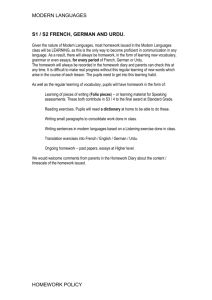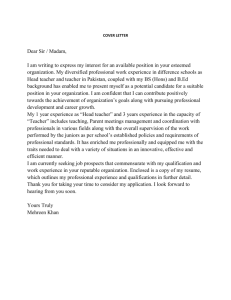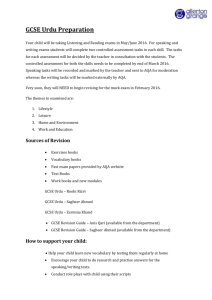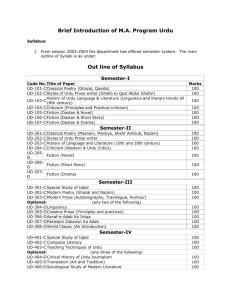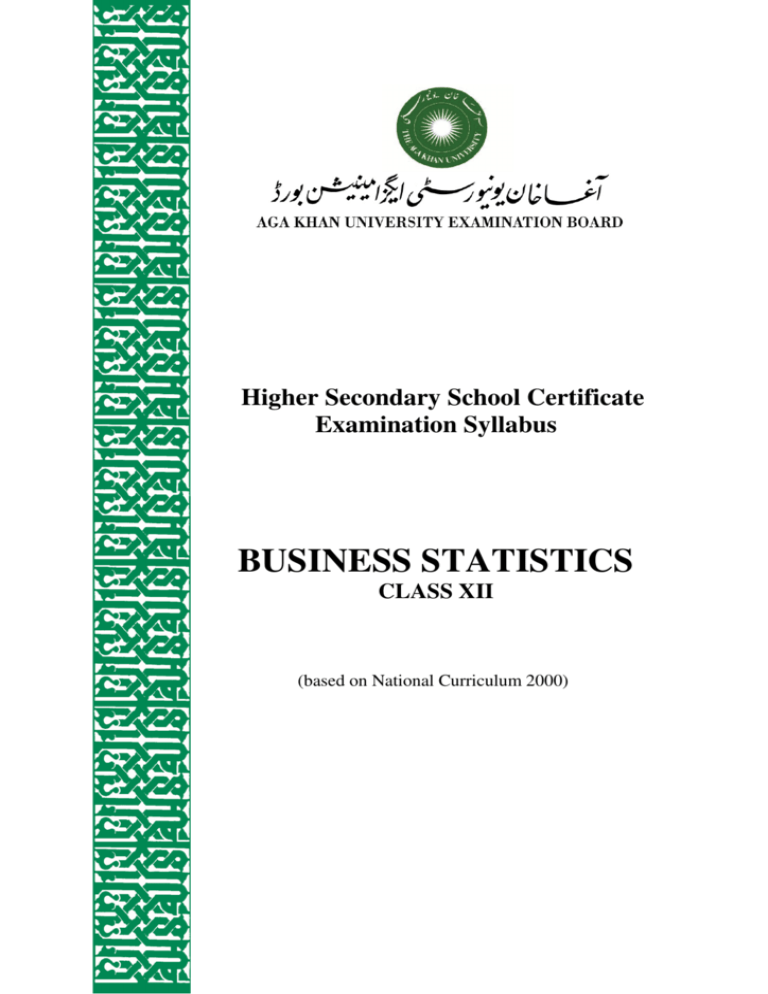
Higher Secondary School Certificate
Examination Syllabus
BUSINESS STATISTICS
CLASS XII
(based on National Curriculum 2000)
Published by
Aga Khan University Examination Board
Bungalow # 233 / E.I.Lines,
Daudpota Road, Karachi, Pakistan.
September 2008
Latest Revision June 2012
All rights reserved
This syllabus is developed by Aga Khan University Examination Board for distribution
to all its affiliated schools.
Higher Secondary School Certificate
Examination Syllabus
BUSINESS STATISTICS
CLASS XII
This subject is examined in both
May and September Examination sessions
S. No.
Table of Contents
Page No.
Preface
5
1.
Rationale of the AKU-EB Examination Syllabus
7
2.
Topics and Student Learning Outcomes of the Examination Syllabus
8
3.
Scheme of Assessment
24
4.
Teaching-Learning Approaches and Classroom Activities
26
5.
Recommended Text and Reference Material
26
6.
Definition of Cognitive Levels and Command Words
27
7.
Annex : SSC Scheme of Studies
29
For queries and feedback
Address:
Phone:
Fax:
E-mail:
Website:
Facebook:
The Aga Khan University Examination Board
Bungalow No. 233/ E.I.Lines, Daudpota Road, Karachi-Pakistan.
(92-21) 35224702-10
(92-21) 35224711
examination.board@aku.edu
http://examinationboard.aku.edu
http://learningsupport.akueb.edu.pk
www.facebook.com/akueb
Latest Revision June 2012
Page 4
PREFACE
In pursuance of National Education Policy (1998-2010), the Curriculum Wing of the Federal
Ministry of Education has begun a process of curriculum reform to improve the quality of
education through curriculum revision and textbook development (Preface, National
Curriculum documents 2000 and 2002).
AKU-EB was founded in August 2003 with the same aim of improving the quality of
education nationwide. As befits an examination board it seeks to reinforce the National
Curriculum revision through the development of appropriate examinations for the Secondary
School Certificate (SSC) and Higher Secondary School Certificate (HSSC) based on the
latest National Curriculum and subject syllabus guidance.
AKU-EB has a mandate by Ordinance CXIV of 2002 to offer such examination services to
English and Urdu medium candidates for SSC and HSSC from private schools anywhere in
Pakistan or abroad, and from government schools with the relevant permissions. It has been
accorded this mandate to introduce a choice of examination and associated educational
approach for schools, thus fulfilling a key objective of the National Curriculum of Pakistan:
“Autonomy will be given to the Examination Boards and Research and Development cells
will be established in each Board to improve the system” (ibid. para. 6.5.3 (ii)).
AKU-EB is committed to creating continuity of educational experience and the best possible
opportunities for its students. In consequence it offered HSSC for the first time in September,
2007 to coincide with the arrival of its first SSC students in college or higher secondary
school. Needless to say this is not an exclusive offer. Private candidates and students joining
AKU-EB affiliated schools and colleges for HSSC Part 1 are eligible to register as AKU-EB
candidates even though they have not hitherto been associated with AKU-EB.
This examination syllabus exemplifies AKU-EB’s commitment to national educational goals.
•
It is in large part a reproduction, with some elaboration, of the Class XII National
Curriculum of the subject.
•
It makes the National Curriculum freely available to the general public.
•
The syllabus recommends a range of suitable textbooks already in print for student
purchase and additional texts for the school library.
•
It identifies areas where teachers should work together to generate classroom activities
and materials for their students as a step towards the introduction of multiple textbooks,
another of the Ministry of Education’s policy provisions for the improvement of higher
secondary education (ibid. para. 6.3.4).
This examination syllabus brings together all those cognitive outcomes of the National
Curriculum statement which can be reliably and validly assessed. While the focus is on the
cognitive domain, particular emphasis is given to the application of knowledge and
understanding, a fundamental activity in fostering “attitudes befitting useful and peaceful
citizens and the skills for and commitment to lifelong learning which is the cornerstone of
national economic development” (Preface to National Curriculum documents 2000 and
2002).
Latest Revision June 2012
Page 5
To achieve this end AKU-EB has brought together university academicians, teacher trainers,
writers of learning materials and above all, experienced teachers, in regular workshops and
subject panel meetings.
AKU-EB provides copies of the examination syllabus to subject teachers in affiliated schools
to help them in planning their teaching. It is the syllabus, not the prescribed textbook which is
the basis of AKU-EB examinations. In addition, the AKU-EB examination syllabus can be
used to identify the training needs of subject teachers and to develop learning support
materials for students. Involving classroom teachers in these activities is an important part of
the AKU-EB strategy for improving the quality of learning in schools.
The Curriculum Wing of the Federal Ministry of Education has recently released new subject
specifications and schemes of study to take effect in September, 2008. These documents are a
major step forward towards a standards-related curriculum and have been welcomed by
AKU-EB. Our current HSSC syllabuses have been revised to ensure conformity with the new
National Curriculum 2006.
We stand committed to all students who have embarked upon the HSSC courses in
facilitating their learning outcomes. Our examination syllabus document ensures all possible
support.
Dr. Thomas Christie
Director,
Aga Khan University Examination Board
July 2009
Latest Revision June 2012
Page 6
1.
Rationale of the AKU-EB Examination Syllabus
1.1
General Rationale
1.1.1
In 2007, the Curriculum Wing of the Federal Ministry of Education (MoE) issued
a revised part-wise Scheme of Studies. It is therefore important for teachers,
students, parents and other stakeholders to know:
(a)
(b)
that the AKU-EB Scheme of Studies for its HSSC examination (Annex)
derives directly from the 2007 Ministry of Education Scheme of Studies;
at which cognitive level or levels (Knowledge, Understanding,
Application and other higher order skills) the topics and sub-topics will be
taught and examined.
1.1.2
This AKU-EB examination syllabus addresses these concerns. Without such
guidance teachers and students have little option other than following a single
textbook to prepare for an external examination. The result is a culture of rote
memorization as the preferred method of examination preparation. The
pedagogically desirable objectives of the National Curriculum which encourage
“observation, creativity and other higher order thinking [skills]” are generally
ignored. AKU-EB recommends that teachers and students use multiple teachinglearning resources for achieving the specific objectives of the National
Curriculum reproduced in the AKU-EB examination syllabuses.
1.1.3
The AKU-EB examination syllabuses use a uniform layout for all subjects to
make them easier for teachers to follow. Blank sheets are provided in each
syllabus for writing notes on potential lesson plans. It is expected that this
arrangement will also be found helpful by teachers in developing classroom
assessments as well as by question setters preparing material for the AKU-EB
external examinations. The AKU-EB aims to enhance the quality of education
through improved classroom practices and improved examinations.
1.1.4
The Student Learning Outcomes (SLOs) in Section 2 start with command words
such as list, describe, relate, explain, etc. The purpose of the command words is to
direct the attention of teachers and students to specific tasks that candidates
following the AKU-EB examination syllabuses are expected to undertake in the
course of their subject studies. The examination questions will be framed using
the same command words or the connotation of the command words, to elicit
evidence of these competencies in candidates’ responses. The definitions of
command words used in this syllabus are given in Section 6. It is hoped that
teachers will find these definitions useful in planning their lessons and classroom
assessments.
1.1.5
The AKU-EB has classified SLOs under the three cognitive levels Knowledge
(K), Understanding (U) and Application of knowledge and skills (A) in order to
derive multiple choice questions and constructed response questions on a rational
basis from the subject syllabuses ensuring that the intentions of the National
Curriculum should be met in full. The weighting of marks to the Multiple Choice
and Constructed Response Papers is also derived from the SLOs, command words
and cognitive levels. In effect the SLOs derived from the National Curriculum
determine the structure of the AKU-EB subject examination set out in Section 3.
1.1.6 Some topics from the National Curriculum have been elaborated and enriched for
better understanding of the subject and/or to better meet the needs of students in
the twenty-first century.
Latest Revision June 2012
Page 7
2.
Topics and Student Learning Outcomes of the Examination Syllabus
Part II (Class XII)
Topics
1. Introduction to Statistics
1.1
1.2
1.3
Nature and Purpose of
Statistics
Data Collection
Types of Data
Student Learning Outcomes
Cognitive Level1
K
U
A
Candidates should be able to:
1.1.1
1.1.2
1.1.3
1.1.4
explain the meaning of statistics;
distinguish between:
i.
descriptive and inferential statistics
ii.
statistic and parameter
iii.
population and sample;
describe uses of statistics and their importance in different fields;
discuss the limitation of statistics;
1.2.1
1.2.2
1.2.3
1.2.4
1.2.5
1.2.6
define primary and secondary data;
distinguish between primary and secondary data;
explain the methods of collection of primary and secondary data;
describe what the term questionnaire means;
write the characteristics of a good questionnaire;
construct a simple questionnaire;
1.3.1
describe constant, variable, quantitative variables/data,
discrete variables/data, continuous variables/data,
qualitative variables/data;
distinguish between:
i.
constant and variable
ii.
quantitative variable and qualitative variable
iii.
discrete variable and continuous variable;
1.3.2
*
*
*
*
*
*
*
*
*
*
*
*
1
K = Knowledge, U = Understanding, A= Application (for explanation see section 6: Definition of command words used in Student Learning Outcomes and in Examination
Questions).
Latest Revision June 2012
Page 8
NOTES
Latest Revision June 2012
Page 9
K
2. Presentation of Statistical
Data
2.1
Frequency Distribution
2.1.1
2.1.2
2.1.3
2.1.4
2.1.5
3. Graphical Representation
3.1
Graphs
Charts
3.1.1
3.1.2
3.1.3
3.2.1
3.2.2
3.2.3
3.2.4
3.2.5
Latest Revision June 2012
A
describe tabulation and its classification;
describe class interval, tally marks/frequency, upper class limit/boundary,
lower class limit/boundary , class mark and class width;
construct a frequency distribution table of discrete and continuous data;
calculate and interpret relative frequency;
calculate and interpret less than cumulative frequency and more than
cumulative frequency.
*
*
*
*
*
Candidates should be able to:
3.1.4
3.1.5
3.2
U
Candidates should be able to:
draw a frequency polygon and extract information from the graph;
draw a histogram and extract information from the graph;
draw a relative frequency histogram and extract information from the
graph;
draw a relative frequency polygon and extract information from the graph;
draw a cumulative frequency polygon or curve (Ogive) and extract
information from the graph;
*
*
*
draw a simple bar chart and extract information from the chart;
draw a multiple bar chart and extract information from the chart;
draw components / subdivided bar chart and extract information from the
charts;
draw a pie chart and extract information from it;
solve problems related to the above mentioned graphs and charts.
*
*
*
*
*
*
*
Page 10
NOTES
Latest Revision June 2012
Page 11
K
4. Measures of Central
Tendency
4.1
Arithmetic Mean
4.1.1
4.1.2
4.1.6
4.1.7
describe the measure of a central tendency;
define the arithmetic mean and weighted arithmetic mean and write their
formulae;
calculate and interpret arithmetic mean (A.M) for ungrouped and grouped
data;
calculate the weighted A.M;
explain the following properties of arithmetic mean:
i.
if X = a (a is constant), then X = a
ii.
if Y = X ± a, then Y = X ± a
iii.
if Y = bX, then Y = b X
X
X
1
iv.
if Y = , then Y =
or Y = ( X )
a
a
a
apply the above mentioned properties to solve related problems;
calculate and interpret the meaning of combined mean;
4.2.1
4.2.2
4.2.3
define the median and write its formula;
calculate and interpret median for ungrouped data and grouped data;
estimate and locate median through a graph ;
*
4.3.1
4.3.2
4.3.3
define mode;
calculate and interpret mode for ungrouped data and grouped data;
estimate and locate mode through a graph;
*
4.4.1
4.4.2
write the empirical relation between mean, median and mode;
use the empirical relationship to solve related problems.
*
4.1.4
4.1.5
4.3
4.4
Median
Mode
Relationship between
Mean, Median and
Mode
Latest Revision June 2012
A
Candidates should be able to:
4.1.3
4.2
U
*
*
*
*
*
*
*
*
*
*
*
*
Page 12
NOTES
Latest Revision June 2012
Page 13
K
5. Measure of Dispersion
5.1
5.2
5.3
Range
Mean Deviation
A
Candidates should be able to:
5.1.1
5.1.2
define the range for grouped and ungrouped data;
calculate and interpret range for grouped and ungrouped data;
*
5.2.1
5.2.2
define mean deviation for grouped and ungrouped data;
calculate and interpret the mean deviation for grouped and ungrouped data;
*
Standard Deviation and 5.3.1
Variance
5.3.2
2
∑x
=
2
n
∑x
or σ 2 =
−
n
2
variance : σ
2
∑ fx
=
∑f
2
standard deviation : σ =
2
2
*
n
∑ fx
or σ 2 =
−
∑f
∑ fx
∑f
*
2
(
2
2
*
∑ (x − x )
)
x−x
∑x
or σ = ∑
;
standard deviation : σ =
−
n
n
n
calculate the variance and standard deviation for grouped data by using
formulas:
∑x
5.3.3
*
describe the variance and standard deviation (S.D.) for grouped and
ungrouped data;
calculate variance and standard deviation for ungrouped data by using
formulas:
variance : σ
Latest Revision June 2012
U
∑ fx
−
∑f
2
*
∑ f (x − x )
∑f
2
∑ f (x − x )
∑f
2
2
or σ =
Page 14
NOTES
Latest Revision June 2012
Page 15
K
6. Index Number
6.1
6.2
6.3
6.4
Index Number
5.3.4
explain the following properties of variance and standard deviation:
i.
S.D. (a) = 0 and Var (a) = 0
ii.
S.D. (X + a) = S.D. (X) and Var (X +a) = Var (X)
iii.
S.D. (X – a) = S.D. (X) and Var (X –a) = Var (X)
iv.
S.D. (aX) = a S.D. (X) and Var (aX) = a 2 Var (X)
X 1
X 1
v.
S.D. = S.D( X )
and
Var = 2 Var( X ) ;
a a
a a
5.3.5
apply the above mentioned properties to solve related problems.
U
*
*
Candidates should be able to:
6.1.1
6.1.2
6.1.3
define index number;
describe price index, quantity index and volume index;
write the uses of index number;
Construction of Index
Number
6.2.1
6.2.2
describe the steps involved in the construction of price index;
calculate index number by fixed base method and by chain base method;
*
Construction of Simple
Price Index Number or
Price Relative
6.3.1
6.3.2
describe the simple price index number;
calculate simple price index and interpret its meaning;
*
Construction of
Composite Index
Number
6.4.1
6.4.2
describe the composite index number;
apply different methods for calculating the composite index number:
i.
simple average of relative method;
ii.
simple aggregative method;
iii.
weighted price index by Laspeyre’s, Paasche’s , Fisher’s and
Marshall – Edgeworth method.
*
Latest Revision June 2012
A
*
*
*
*
*
*
Page 16
NOTES
Latest Revision June 2012
Page 17
K
6.5
Properties of Index
Number
6.5.1
describe the following properties of index numbers;
p
if I a , b = b , then
pa
p
i.
Ia, a = a = 1
pa
p
ii.
Ia,b = b
pa
1
Ia,b =
pa
pb
1
Ib , a =
Ib , a
iii.
I a , b × Ib , c × Ic , d =
I a , b × Ib , c × Ic , d =
I a , b × Ib , c × Ic , d
pb
pa
×
U
*
A
p
pc
× d
pb
pc
pd
pa
= pd ,a
where p a , pb , pc and p d being the prices of a commodity in the years a,
b, c and d respectively. I a , b is only a ratio and not a percentage. The factor
6.5.2
6.5.3
Latest Revision June 2012
100 is neglected to avoid confusion.
prove the above mentioned properties of index number;
solve problems related to the above mentioned properties of index number;
*
*
Page 18
NOTES
Latest Revision June 2012
Page 19
K
7. Counting Techniques and
Probability
7.1
Counting Techniques
7.3
Permutation
Combination
Latest Revision June 2012
A
Candidates should be able to:
7.1.1
7.1.2
7.1.3
7.1.4
7.2
U
7.2.1
7.2.2
identify n! as the notation to express the product of the first n natural
numbers;
describe the fundamental principle of counting;
illustrate the fundamental principle of counting by using tree diagram;
solve problems related to fundamental principle of counting and tree
diagram;
*
*
*
*
*
7.2.3
describe permutation;
apply the formula of permutation for:
i.
n different objects taken r at a time ( repetition is not allowed)
n different objects taken r at a time ( repetition is allowed)
ii.
iii.
n objects when n1 are alike, n2 are alike, n3 are alike,…………. nk
are alike where n = n1 + n2 + n3 + ............. + nk ;
solve problems related to permutation;
7.3.1
7.3.2
describe combination;
apply the formula of combination to solve related problems;
*
*
*
*
Page 20
NOTES
Latest Revision June 2012
Page 21
K
7.4
Basic Concepts of
Probability
Latest Revision June 2012
7.4.1
describe basic terms used in probability like experiment , outcome, sample
space and events;
7.4.2 describe probability;
7.4.3 write the axioms of probability;
7.4.4 calculate probability of an event in simple cases;
7.4.5 distinguish between mutually exclusive and non mutually exclusive
events;
7.4.6 describe the addition rule of probability for mutually exclusive events
i.e. P ( A ∪ B ) = P ( A) + P ( B ) ;
7.4.7 describe the general addition rule of probability
i.e. P( A ∪ B ) = P( A) + P(B ) − P( A ∪ B ) ;
7.4.8 distinguish between dependent and independent events;
7.4.9 define conditional probability;
7.4.10 describe the law of multiplication of probability
P ( A ∩ B ) = P ( A) × P ( B | A) OR P ( A ∩ B ) = P ( B ) × P ( A | B )
where P(B|A) and P(A|B) are conditional probabilities and
A and B are dependent events;
7.4.11 describe the law of multiplication of probability
P ( A ∩ B ) = P ( A) × P ( B ) where A and B are independent events;
7.4.12 apply the above mentioned laws of addition and multiplication of
probability to solve related problems;
U
*
A
*
*
*
*
*
*
*
*
*
*
*
Page 22
NOTES
Latest Revision June 2012
Page 23
3.
Scheme of Assessment
Class XII
Table 1: Number of Student Learning Outcomes by Cognitive Level
Topic
No
1.
2.
3.
4.
5.
6.
7.
Topics
Introduction to Statistics
Presentation of Statistical Data
Graphical Representation
Measures of Central Tendency
Measures of Dispersion
Index Number
Counting Technique and
Probability
Total
Percentage
SLOs
U
10
3
0
2
2
6
No. of
Sub Topics
3
1
2
4
3
5
K
2
0
0
4
2
2
4
3
12
6
21
22
13
16
35
42
35
42
83
100
Total
A
0
2
10
9
4
4
12
5
10
15
8
12
Table 2: Allocation of Marks for the Multiple Choice Questions (MCQs),
and Constructed Response Questions (CRQs)
Topic
No
1.
2.
3.
4.
5.
6.
7.
Topics
Introduction to Statistics
Presentation of Statistical
Data
Graphical Representation
Measures of Central
Tendency
Measures of Dispersion
Index Number
Counting Technique and
Probability
Total
Latest Revision June 2012
No. of
Sub Topics
3
Marks
Multiple Constructed
Choice
Response
Questions Questions
3
4
Total
7
1
2
4
6
2
3
4
7
4
4
5
9
3
5
2
2
4
5
6
7
4
4
4
8
21
20
30
50
Page 24
Table 3: Paper Specifications
Topic
No.
Topics
1.
Introduction to Statistics
2.
Presentation of Statistical Data
3.
Graphical Representation
4.
Measure of Central Tendency
5.
Measure of Dispersion
6.
Index Number
7.
Counting Technique and
Probability
Total
*
Marks Distributions
MCQs 3 @ 1 Mark
CRQ 1 @ 4 Marks
MCQs 2 @ 1 Mark
CRQ 1 @ 4 Marks
MCQs 3 @ 1 Mark
CRQ 1 @ 4 Marks
MCQs 4 @ 1 Mark
*CRQs 2 @ 5 Marks each
Choose any ONE from TWO
MCQs 2 @ 1 Mark
CRQ 1 @ 4 Marks
MCQs 2 @ 1 Mark
*CRQs 2 @ 5 Marks each
Choose any ONE from TWO
MCQs 4 @ 1 Mark
*CRQs 2 @ 4 Marks each
Choose any ONE from TWO
MCQs
CRQs
20
30
Total
Marks
7
6
7
9
6
7
8
50
There will be TWO questions and the candidates will be required to attempt any
ONE by making a choice out of the TWO.
3.1
Table 1 indicates the number and nature of SLOs in each topic in class XII. This will
server as a guide in the construction of the examination paper. It also indicates that
more emphasis has been given to the understanding (42%) application and higher order
skills (42%) in class XII to discourage rote memorization. Table 1, however, does not
translate directly into marks.
3.2
Table 2 shows the distribution of marks. There will be 20 marks of multiple choice
questions each carrying one mark. The constructed response paper will carry 30
marks. It is AKU-EB policy that every topic should be examined.
3.3
The question paper will be in two parts: paper I and paper II. Both papers will be of
duration of 2 hours.
3.4
Paper I will be a separately timed objective test of 30 minutes, administered before the
constructed response paper (paper II). There will be no choice in the multiple choice
paper.
3.5
Paper II will carry 30 marks and consist of a number of compulsory, constructed
response questions. There will be no choice among the chapters in constructed
response questions but it may be within the topics.
3.6
All constructed response questions will be in a booklet which will also serve as an
answer script.
Latest Revision June 2012
Page 25
4.
Teaching–Learning Approaches and Classroom Activities
4.1
As the AKU-EB syllabus focuses on understanding and higher order thinking skills,
teachers need to encourage activity and problem-based classroom practices.
4.2
The following strategies are recommended:
4.2.1
Before starting any topic, teachers should give the relevant information from
that topic to build up and recall their previous knowledge if they have.
4.2.2
Lecture should be well organised and completed within limited time period
with current and practical examples.
4.2.3
To understand the cognitive level of ongoing topics, teacher(s) should provide
hard copies of syllabus to the students.
4.2.4
During lecture, teacher(s) should ask the questions randomly from the students
to assist the student, are they understanding or not.
4.2.5
If a teacher feels that a student does not understand, the student should be
called to the board to clarify the concept. This will facilitate the student to
comprehend more accurately.
4.2.6
Take a presentation from the students on selected and applied topics from the
syllabus.
4.2.7
Arrange educational trips to different organisations and institutes, i.e. banks
and other sort of financial institutes.
4.2.8
Assign tasks to the students to search relevant material from other sources, i.e.
library, internet and news papers etc.
4.2.9
Organise group discussions among students to share their views about on
going topic.
4.2.10 Plan to organise a meeting of students with different professionals and
intellectuals. It will provide moral support and boost their confidence levels.
Latest Revision June 2012
Page 26
5.
Recommended Texts, Reference Materials
Recommended Books
1. Hamid A. Hakim (2006). Fundamentals of Business Statistics. Karachi: Meyari
Matbooat.
2. Nadeem Akhter Siddiqui (2001). Business Statistics, Lahore: Azeem Academy.
Reference Books
1. Schaum’s Outline Murray R. Spiegel and Larry J. Stephens (1993). Statistics.
McGraw Hill JBD Press.
2. Earl K. Bowen and Martin K. Starr (1982). Basic Statistics for Business and
Economics. McGraw-Hill.
Recommended Websites
http://math.about.com/library/weekly
http://www.textbooks.com/Cat.php?SBC=MEX
www.webbertext.com/index.html
6.
Definition of Cognitive Levels and Command Words
6.1
Definition of Cognitive Levels
Knowledge
This requires knowing and remembering facts and figures, vocabulary and contexts,
and the ability to recall key ideas, concepts, trends, sequences, categories, etc. It can
be taught and evaluated through questions based on: who, when, where, what, list,
define, describe, identify, label, tabulate, quote, name, state, etc.
Understanding
This requires understanding information, grasping meaning, interpreting facts,
comparing, contrasting, grouping, inferring causes/reasons, seeing patterns,
organizing parts, making links, summarizing, solving, identifying motives, finding
evidence, etc. It can be taught and evaluated through questions based on: why, how,
show, demonstrate, paraphrase, interpret, summarise, explain, prove, identify the main
idea/theme, predict, compare, differentiate, discuss, chart the course/direction, report,
solve, etc.
Application
This requires using information or concepts in new situations, solving problems,
organizing information and ideas, using old ideas to create new ones, generalizing
from given facts, analyzing relationships, relating knowledge from several areas,
drawing conclusions, evaluating worth, etc. It can be taught and evaluated through
questions based on: distinguish, analyse, show relationship, propose an alternative,
prioritize, give reasons for, categorize, illustrate, corroborate, compare and contrast,
create, design, formulate, integrate, re-arrange, reconstruct/recreate, re-organize,
predict consequences etc.
Latest Revision June 2012
Page 27
6.2
Definition of Command Words
Knowledge
Define:
Only a formal statement or equivalent paraphrase is required. No
examples need to be given.
Identify:
Pick out, recognizing specified information from a given content or
situation.
Write:
To compose, execute or produce in words, characters or figures.
Understanding
To set in order or something formulated or built systematically
or frame a concept, model, or schematic idea.
To state in words (using diagrams where appropriate) the main
points of the topic.
Construct:
Describe:
Discuss:
To give a critical account of the points involved in the topic.
Distinguish:
To identify those characteristics which always or sometimes
distinguish between two categories.
Explain:
To give reason or use some reference to theory, depending on
the context.
Illustrate:
To give clear examples to state, clarify or synthesize a point of
view.
Interpret:
To translate information from observation, charts, tables, graphs,
and written material in a supportable manner.
Locate:
To place or to set in a particular spot or position.
Application
Apply:
To use the available information in different contexts to relate and
draw conclusions.
Calculate:
Is used when a numerical answer is required. In general, working
should be shown, especially where two or more steps are involved.
Draw:
To make a simple freehand sketch or diagram. Care should be
taken with proportions and the clear labelling of parts.
Estimate:
To calculate approximately (the amount, extent, magnitude,
position, or value of something).
Latest Revision June 2012
Page 28
Find:
Is a general term that may variously be interpreted as calculate,
measure, determine, etc.
In other contexts, describe and give an account of should be
interpreted more generally, i.e. the candidate has greater discretion
about the nature and the organization of the material to be
included in the answer. Describe and explain may be coupled in a
similar way to state and explain.
Solve:
To work out systematically the answer of a given problem.
Use:
To deploy the required attribute in a constructed response.
Latest Revision June 2012
Page 29
Annex
HSSC Scheme of Studies
2
AKU-EB as a national board offers SSC and HSSC qualifications for both English and Urdu
medium schools. The revised HSSC Scheme of Studies issued by the Curriculum Wing was
implemented from September 2007. The marks allocated to subjects in the revised National
Scheme of Studies have been followed.
HSSC I-II (Classes XI-XII) subjects on offer for examination
HSSC Part-I (Class XI) Science Group (Pre-Medical)
Subjects
English Compulsory-I
Urdu Compulsory-I OR
Pakistan Culture-I a
Physics-I
Chemistry-I
Biology-I
Total:
Theory
100
Marks
Practical
-
Total
100
100
-
100
85
85
85
455
15
15
15
45
100
100
100
500
Medium
English
Urdu
English
English
English
English
HSSC Part-II (Class XII) Science Group (Pre-Medical)
Subjects
English Compulsory-II
Urdu Compulsory-II OR
Pakistan Culture-II a
Islamiyat OR Ethics b
Pakistan Studies
Physics-II
Chemistry-II
Biology-II
Total:
a.
b.
Theory
100
Marks
Practical
-
Total
100
100
-
100
50
50
85
85
85
555
15
15
15
45
50
50
100
100
100
600
Medium
English
Urdu
English
English / Urdu
English / Urdu
English
English
English
Foreign students may opt for Pakistan Culture in lieu of Urdu Compulsory, subject to the Board’s
approval.
For non-Muslim candidates in lieu of Islamiyat.
Note: Pakistan Studies, Islamiyat / Ethics will be taught in Classes XI and XII, but the examination will
be conducted at the end of Class XII.
2
Government of Pakistan September 2007. Scheme of Studies for SSC and HSSC (Classes IX-XII). Islamabad: Ministry of Education,
Curriculum Wing.
Latest Revision June 2012
Page 30
HSSC Part-I (Class XI) Science Group (Pre-Engineering)
Marks
Subjects
Theory Practical
English Compulsory-I
100
Urdu Compulsory-I OR
100
Pakistan Culture-I a
Physics-I
85
15
Chemistry-I
85
15
Mathematics-I
100
Total:
470
30
HSSC Part-II (Class XII) Science Group (Pre-Engineering)
Marks
Subjects
Theory Practical
English Compulsory-II
100
Urdu Compulsory-II OR
100
Pakistan Culture-II a
50
Islamiyat OR Ethics b
Pakistan Studies
50
Physics-II
85
15
Chemistry-II
85
15
Mathematics –II
100
Total:
570
30
a.
b.
Total
100
100
100
100
100
500
Total
100
100
50
50
100
100
100
600
Medium
English
Urdu
English
English
English
English
Medium
English
Urdu
English
English / Urdu
English / Urdu
English
English
English
Foreign students may opt for Pakistan Culture in lieu of Urdu Compulsory, subject to the Board’s
approval.
For non-Muslim candidates in lieu of Islamiyat.
Note: Pakistan Studies, Islamiyat / Ethics will be taught in Classes XI and XII, but the examination will
be conducted at the end of Class XII.
Latest Revision June 2012
Page 31
HSSC Part-I (Class XI) Science Group (Science General)
Marks
Subjects
Theory Practical
English Compulsory-I
100
Urdu Compulsory-I
100
Pakistan Culture-I a
Any one subject combinations of the following:
Physics-I
85
15
Mathematics-I
100
*Statistics-I
85
15
Economics-I
100
Mathematics-I
100
*Statistics-I
85
15
Economics-I
100
Mathematics-I
100
Computer Science-I
75
25
Physics-I
85
15
Mathematics-I
100
Computer Science-I
75
25
Mathematics-I
100
*Statistics-I
85
15
Computer Science-I
75
25
Total:
HSSC Part-II (Class XII) Science Group (Science General)
Marks
Subjects
Theory Practical
English Compulsory-II
100
Urdu Compulsory-II OR
100
Pakistan Culture-II a
50
Islamiyat OR Ethics b
Pakistan Studies
50
Any one subject combinations of the following:
Physics-II
85
15
Mathematics-II
100
*Statistics-II
85
15
Economics-II
100
Mathematics-II
100
*Statistics-II
85
15
Economics-II
100
Mathematics-II
100
Computer Science-II
75
25
Physics-II
85
15
Mathematics-II
100
Computer Science-II
75
25
Mathematics-II
100
*Statistics-II
85
15
Computer Science-II
75
25
Total:
Total
100
100
300
300
300
300
300
Medium
English
Urdu
English
English
English
English
English / Urdu
English
English
English / Urdu
English
English
English
English
English
English
English
English
500
Total
100
100
50
50
300
300
300
300
300
Medium
English
Urdu
English
English / Urdu
English / Urdu
English
English
English
English / Urdu
English
English
English / Urdu
English
English
English
English
English
English
English
English
600
a.
Foreign students may opt for Pakistan Culture in lieu of Urdu Compulsory, subject to the Board’s
approval.
b. For non-Muslim candidates in lieu of Islamiyat.
Note: Pakistan Studies, Islamiyat / Ethics will be taught in Classes XI and XII, but the examination will
be conducted at the end of Class XII.
*These subject is offered ONLY in the May examination.
Latest Revision June 2012
Page 32
HSSC Part-I (Class XI) Commerce Group
Subjects
English Compulsory-I
Urdu Compulsory-I OR
Pakistan Culture-I a
Principles of Accounting-I
Principles of Economics
Principles of Commerce
Business Mathematics
Total:
Theory
100
100
Marks
Practical
-
Total
100
100
100
75
75
50
500
-
100
75
75
50
500
Theory
100
Marks
Practical
-
Total
100
100
-
100
50
50
100
75
60
OR
75
50
600
-
50
50
100
75
English
Urdu
English
English / Urdu
English / Urdu
English
English
75
English
50
600
English
Medium
English
Urdu
English
English
English
English
English
HSSC Part-II (Class XII) Commerce Group
Subjects
English Compulsory-II
Urdu Compulsory-II OR
Pakistan Culture-II a
Islamiyat OR Ethics b
Pakistan Studies
Principles of Accounting-II
Commercial Geography
*Computer Studies
OR
Banking
Business Statistics
Total:
a.
b.
Medium
15
-
Foreign students may opt for Pakistan Culture in lieu of Urdu Compulsory, subject to the Board’s
approval.
For non-Muslim candidates in lieu of Islamiyat.
Note: Pakistan Studies, Islamiyat / Ethics will be taught in Classes XI and XII, but the examination will
be conducted at the end of Class XII.
*This subjects are offered ONLY in the May examination.
Latest Revision June 2012
Page 33
HSSC Part-I (Class XI) Humanities Group
Subjects
English Compulsory-I
Urdu Compulsory-I OR
Pakistan Culture-I a
Any three of the following Elective Subjects
1.
Civics-I
2.
Computer Science-I (75+25 practical)
3.
Economics-I
4.
*Education-I
5.
*Geography-I (85+15 practical)
6.
*Islamic Studies-I
7.
*Islamic History-I
8.
Literature in English-I
9.
Mathematics-I
10. *Psychology-I (85+15 practical)
11. *Statistics-I (85+15 practical)
12. *Sociology-I
13. Urdu Literature-I
14. *Fine Arts-I
Total:
HSSC Part-II (Class XII) Humanities Group
Subjects
English Compulsory-II
Urdu Compulsory-II OR
Pakistan Culture-II a
Islamiyat OR Ethics b
Pakistan Studies
Any three of the following Elective Subjects
1.
Civics-II
2.
Computer Science-II (75+25 practical)
3.
Economics-II
4.
*Education-II
5.
*Geography-II (85+15 practical)
6.
*Islamic Studies-II
7.
*Islamic History-II
8.
Literature in English-II
9.
Mathematics-II
10. *Psychology-II (85+15 practical)
11. *Statistics-II (85+15 practical)
12. *Sociology-II
13. Urdu Literature-II
14. *Fine Arts-II
Total:
a.
b.
Marks
100
100
300
(100
each)
Medium
English
Urdu
English
English / Urdu
English
English / Urdu
English / Urdu
English / Urdu
English / Urdu
English / Urdu
English
English
English / Urdu
English
English / Urdu
Urdu
English
500
Marks
100
100
50
50
300
(100
each)
Medium
English
Urdu
English
English / Urdu
English / Urdu
English / Urdu
English
English / Urdu
English / Urdu
English / Urdu
English / Urdu
English / Urdu
English
English
English / Urdu
English
English / Urdu
Urdu
English
600
Foreign students may opt for Pakistan Culture in lieu of Urdu Compulsory, subject to the Board’s
approval.
For non-Muslim candidates in lieu of Islamiyat.
Note: Pakistan Studies, Islamiyat / Ethics will be taught in Classes XI and XII, but the examination will
be conducted at the end of Class XII.
*These subjects are offered ONLY in the May examination.
Latest Revision June 2012
Page 34

